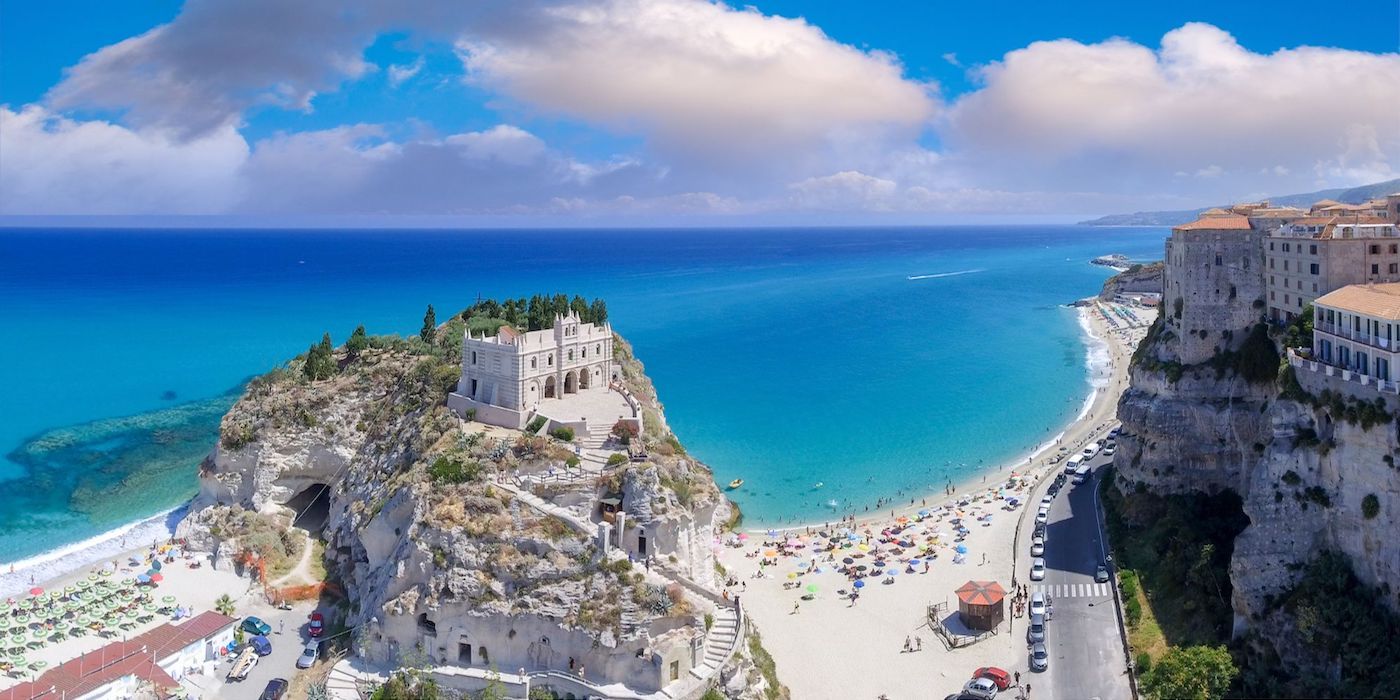Perched on a cliff overlooking the Tyrrhenian Sea and nestled in the heart of an extraordinary region, Tropea is one of Calabria's most enchanting destinations.
You’ll fall in love at first sight with the vistas of white sandy beaches and turquoise waters, while the perched houses and picturesque streets of the historic center tell centuries-old stories, conveying the charm of an authentic atmosphere and a touch of Mediterranean magic.
Beyond its breathtaking landscapes, Tropea is also rich in traditions that reflect its Calabrian soul, starting with the excellent local products such as the famous red onion of Tropea, known worldwide for its sweetness and quality. Visiting Tropea means experiencing a memorable journey through history, flavors, and stunning scenery.
Download the Offline Guide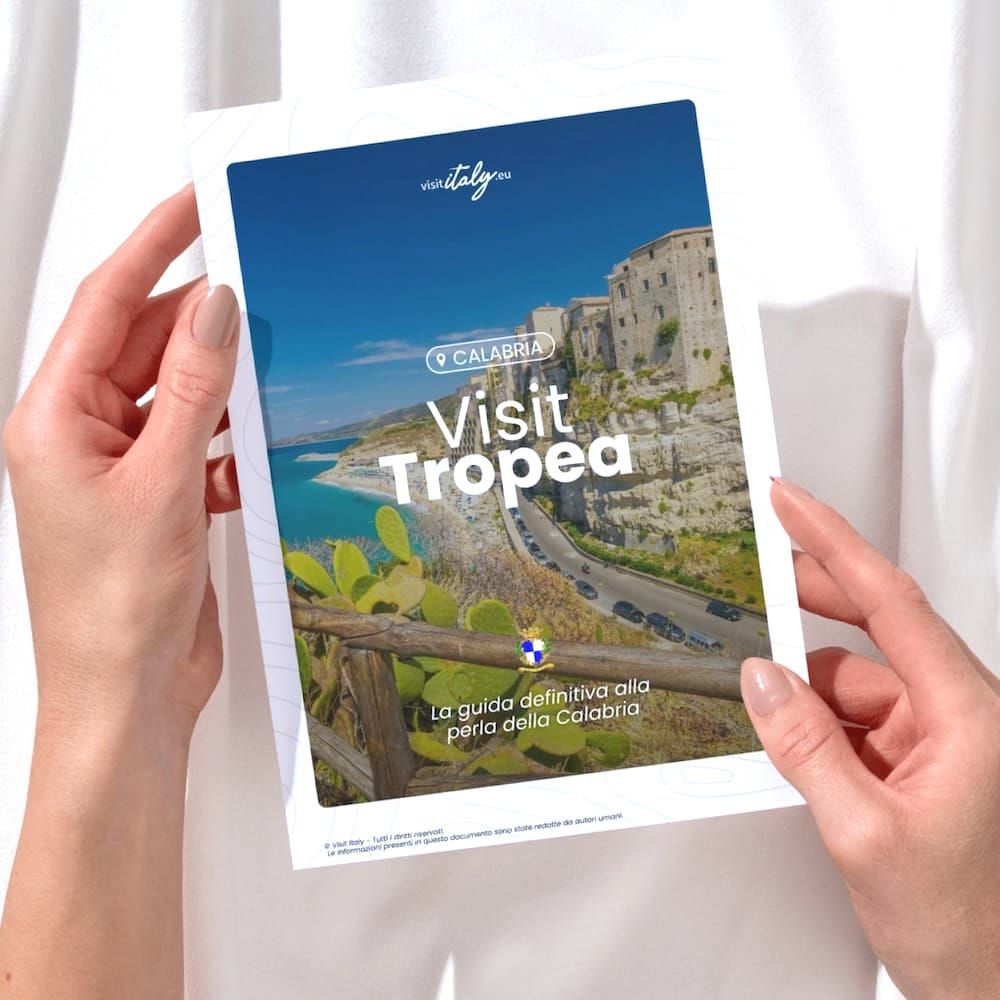
Where is Tropea located?
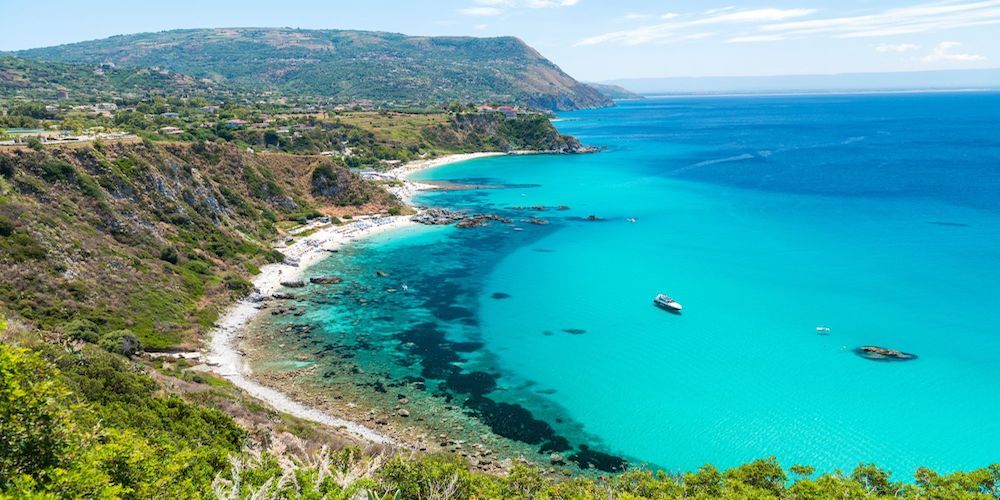
Tropea is located in the heart of the stunning Coast of the Gods, on the Tyrrhenian coast of Calabria, in a prime position surrounded by breathtaking landscapes.
The Coast of the Gods is a truly special area, stretching from the charming town of Pizzo in the north to the historic village of Nicotera in the south.
Not by chance, the name itself evokes not only an image of divine beauty but also the sense of wonder and awe that every visitor experiences in the face of such a captivating landscape.
Along this stretch of coastline, you can admire spectacular cliffs overlooking the sea, hidden coves, and long stretches of golden sandy beaches, interspersed with crystal-clear waters that create a stunning contrast with the lush green hills surrounding them.
In addition to the beauty of the sea, the Costa degli Dei also offers another dimension of tranquility. If you seek moments of relaxation and a pace of life in harmony with nature, the hills of the hinterland are an ideal refuge. Immerse yourself in the woods, olive groves and vineyards, and discover a rural beauty that will offer you the chance to escape from the daily hustle and find the perfect inner balance.
Tropea and its beaches: hidden paradises and breathtaking views
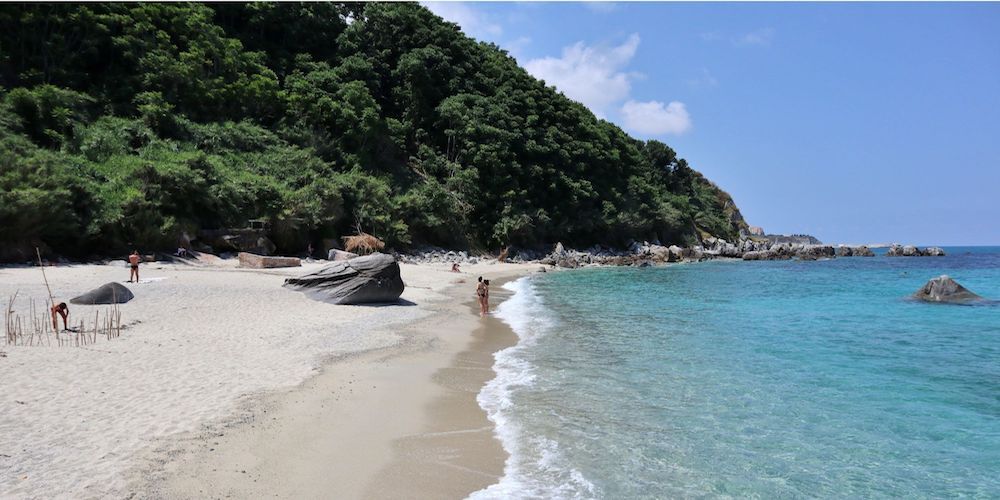
One of the most extraordinary gems of the Coast of the Gods is undoubtedly its beaches. The beaches of Tropea, in particular, reveal true hidden paradises, with their fine white sand and stunning landscapes.
Start your journey with the Spiaggia della Rotonda, located right below the cliff where the old town sits.
Here, the landscape stretches over the deep blue of the sea and the vibrant green vegetation covering the surrounding coast. Especially during the summer months, the atmosphere is lively and vibrant, yet despite the number of visitors, the beach always retains its authentic charm.
If you want to combine the beauty of the sea with Tropea's cultural allure, head towards the adjacent Spiaggia del Convento, a public beach nestled beneath the iconic rock where the Sanctuary of Santa Maria dell’Isola stands tall.
At the base of the cliff, you will also find the stunning Grotta del Palombaro, which you can reach by swimming or snorkeling.
Venturing further from the old town and past San Leonardo Rock, you'll arrive at the small and peaceful Spiaggia del Cannone. Continuing beyond the port, you’ll reach a less scenic and more expansive shoreline, the Spiaggia della Contura, with its wide-open view of the sea.
Finally, it’s worth traveling just a couple of kilometers north to discover Spiaggia Michelino, a hidden gem offering a serene and intimate atmosphere. To reach it, you’ll descend a long staircase leading to a stretch of golden sand framed by towering cliffs — a peaceful corner of unspoiled nature where the gentle waves of a crystalline sea lap the shore.
Time travel in Tropea: ancient history and medieval remains
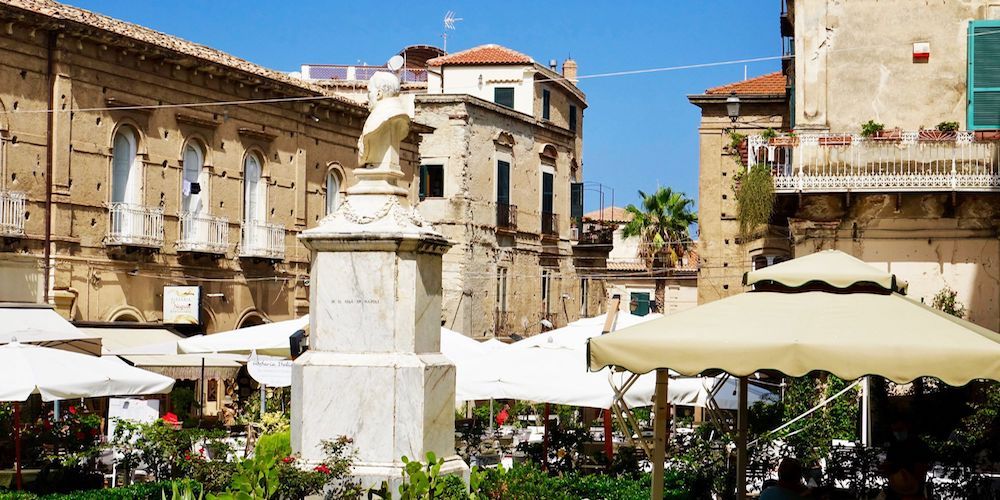
Strolling through the historic center of Tropea gives you the feeling of immersing yourself in a history with deep and ancient roots. The origins of the city date back to the Greek era, but it was under the Romans that Tropea gained importance, especially due to its strategic position on the Tyrrhenian coast.
Evidence of the Roman period can be found outside the center, in the surrounding area. For instance, you can find traces at the Pizzuta rock, where remnants of submerged columns and capitals are still visible, or in the inland districts.
In the historic center, it almost feels like you can hear the echoes of the Normans and Aragonese, who left their mark on the urban fabric and local culture during the Middle Ages.
Noble palaces were built, scattered throughout the charming streets of the village, along with significant churches, such as the Cathedral of Maria Santissima di Romania, the Norman cathedral erected between the 12th and 13th centuries. The defensive walls were reinforced during Spanish rule, and even the Sanctuary of Santa Maria dell’Isola, which has very ancient origins, was restored and enriched during this period.
Every corner of the town holds significant historical traces, as the history of Tropea is that of a proud people who have managed to preserve their true identity, making the city a place where the past remains vivid and pulsating.
The authentic atmosphere of Tropea: traditions, events and typical products
Tropea is not just a destination: it’s an experience that remains in your heart and memory, offering a unique journey into the most authentic Calabria.
Every corner of the village tells a story full of traditions and passion, with a timeless atmosphere that emerges among the cobbled streets and local artisan shops of the historic center, where you can discover the secrets of local crafts and trades.
Calabrian culture is also celebrated through typical products, starting with the famous red onion of Tropea, renowned for its quality and versatility in cooking, as well as being an unmistakable symbol of the area's ancient gastronomic tradition.
The local cuisine is indeed rich in history, with dishes prepared according to recipes passed down through the centuries, celebrating the use of fresh ingredients and traditional culinary techniques.
Among the traditional events, if you find yourself in Tropea at the beginning of May, don’t miss the "Tri da Cruci" celebrations, where the streets fill with colors and sounds, and the sky above Piazza del Cannone lights up with an extraordinary fireworks display.
Another significant celebration is dedicated to the Madonna di Romania, held on March 27 and September 9, an occasion that involves the entire community in an act of deep devotion.
Legend has it that a sailor saved a painting of the Madonna and brought it to Tropea. There, the ship he was on became stranded in the port until the Bishop dreamed of the Madonna asking him to make her stay in Tropea. Indeed, as soon as the painting was brought ashore, the ship was able to depart, and the Madonna promised to protect Tropea for centuries to come.
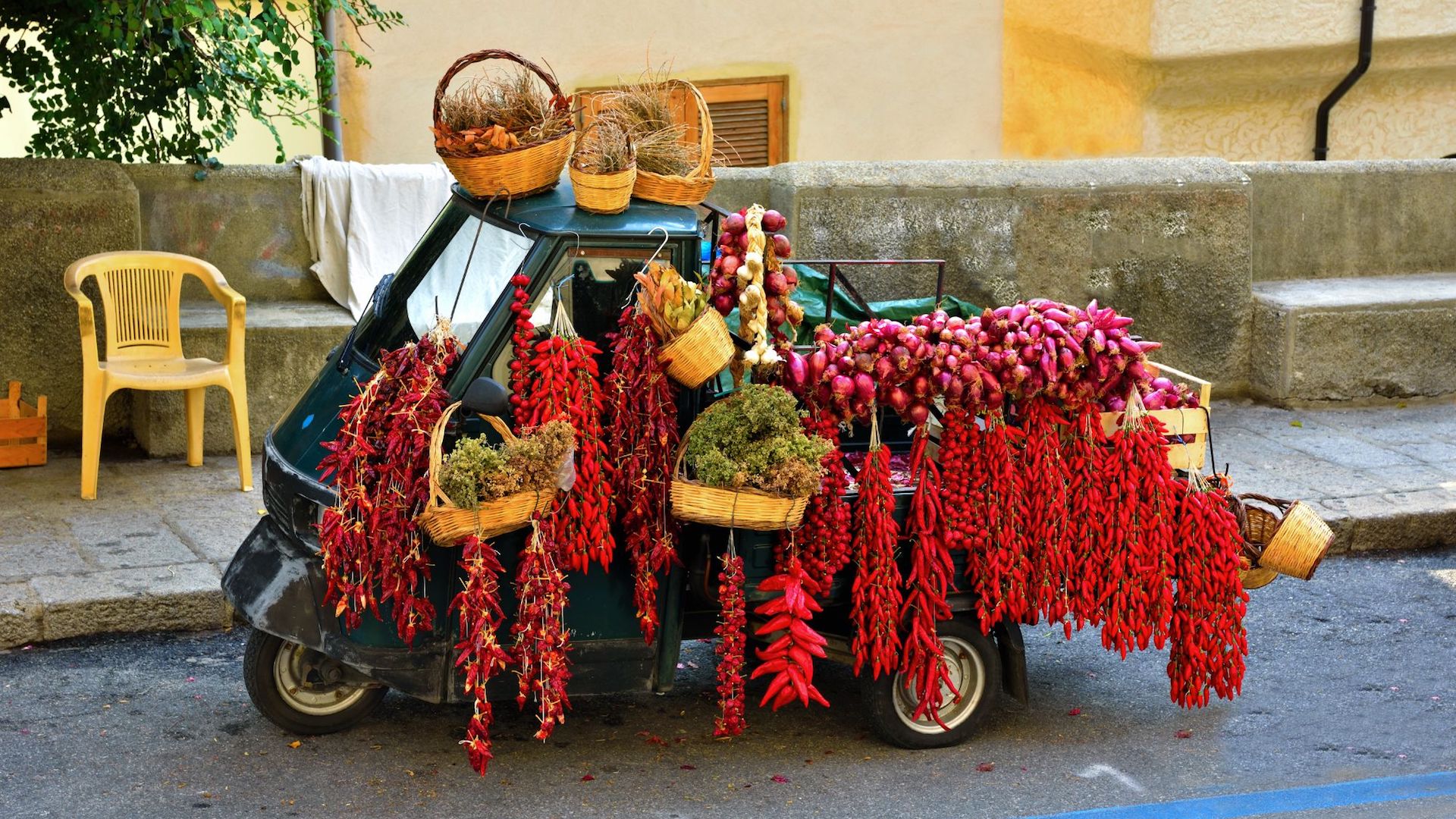
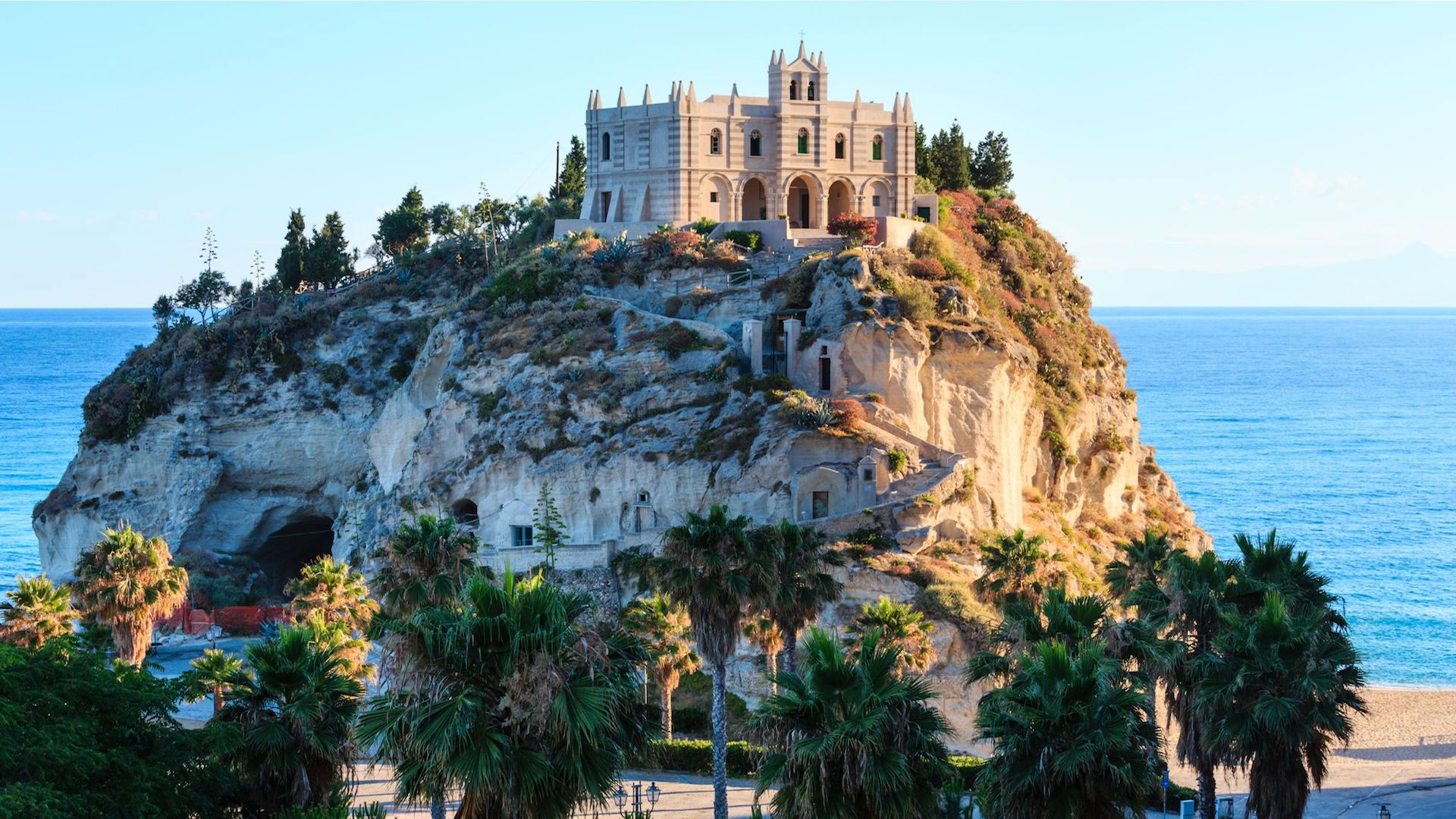
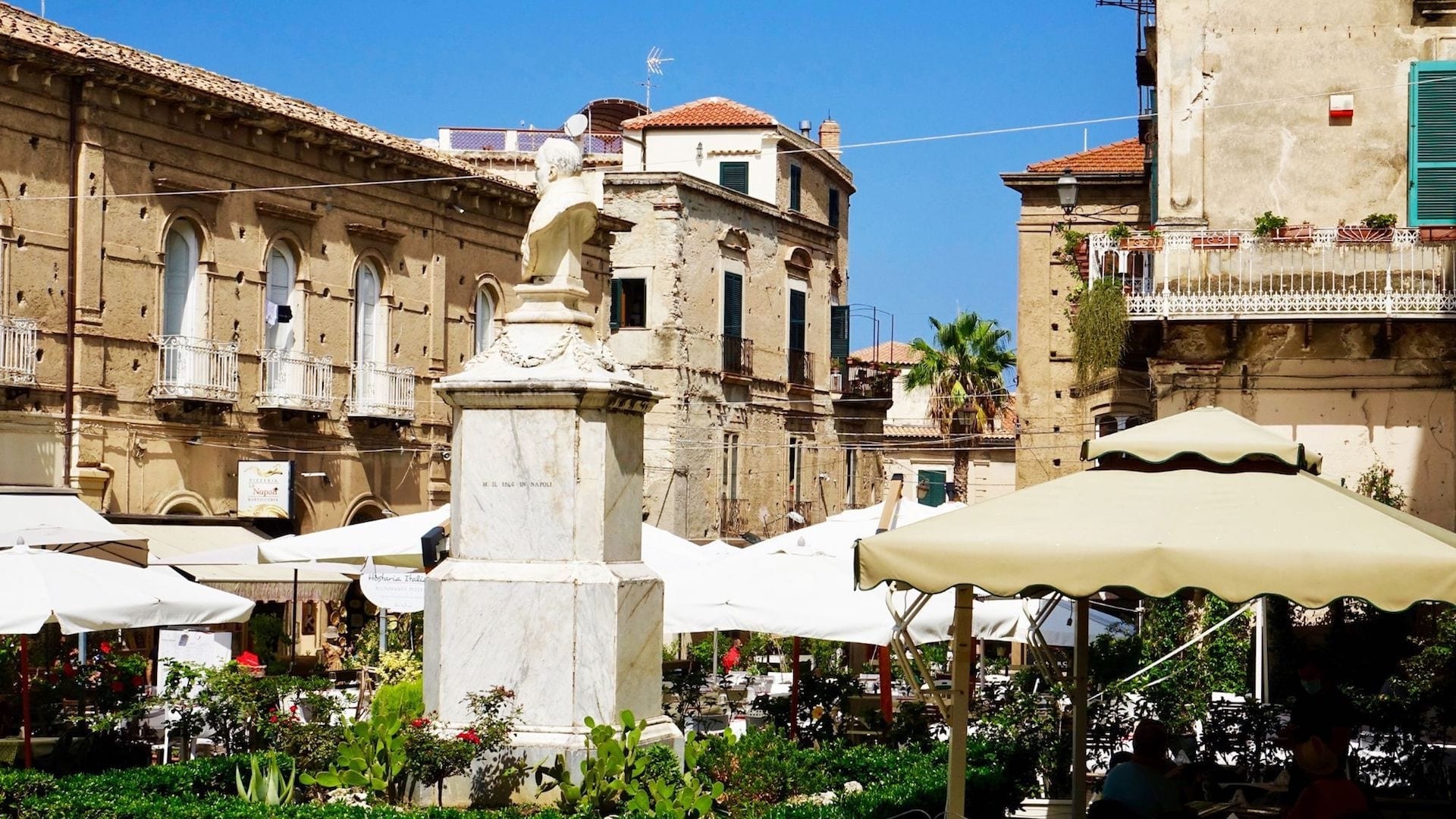
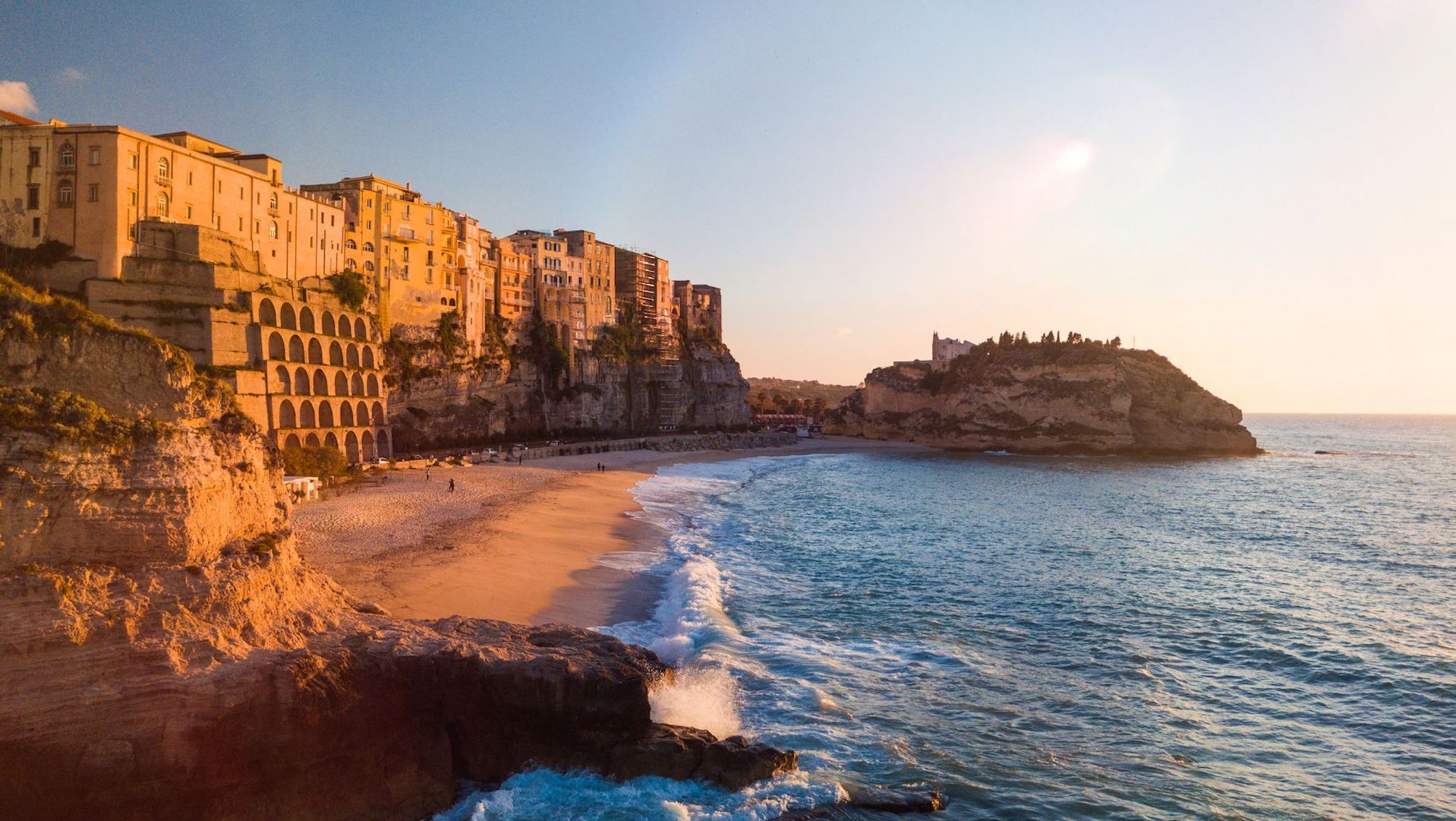
What to see in Tropea: discover the unmissable attractions

Squares, museums, historic buildings; but also breathtaking views, beaches, and typical products so extraordinary they have become icons of the city.
Tropea is a place where boredom is not an option, and where you can spend several days exploring all the main attractions, from the most famous to the lesser-known and characteristic spots.
Get ready to travel through time, discovering history, spirituality, and religious traditions, exploring historic palaces and local shops, walking on fine sand, and admiring cliffs plunging into the crystal-clear waters of a sea that frames a fairytale setting.
Tropea's Sanctuary: history, legends and breathtaking landscapes
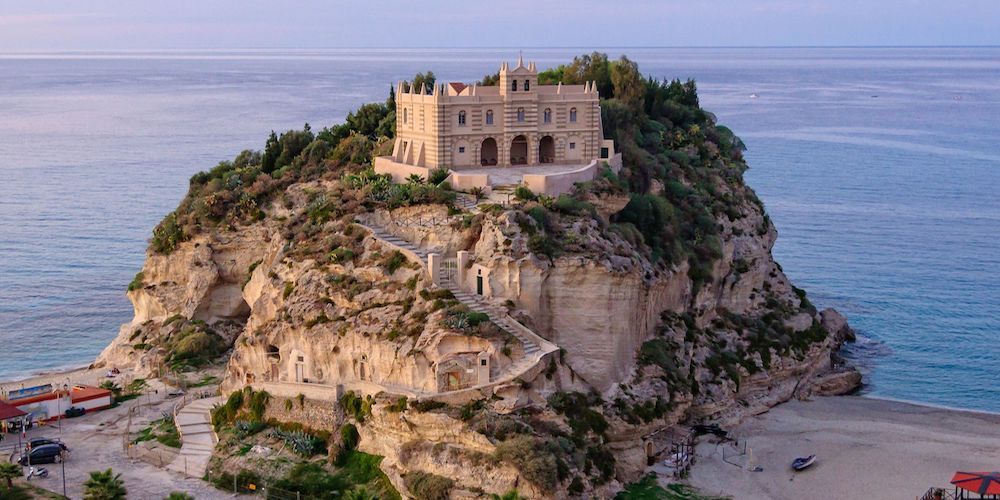
A magical place both for its historical and religious significance and for the breathtaking location that makes it perhaps the most renowned and iconic attraction in Tropea.
The Sanctuary of Santa Maria dell’Isola is situated in a spectacular position on a rocky promontory overlooking the Tyrrhenian Sea, offering a stunning view of the town, the beaches and the coast. The name itself comes from the fact that, in the past, the rock on which it stands was an island completely surrounded by the sea.
While the exterior of the Sanctuary conveys a perfect sense of harmony with nature, inviting silence and contemplation, the atmosphere inside will transport you back in time, amid ancient stories and local legends.
One such legend concerns the statue of the miraculous Madonna, which arrived in Tropea from the East during the Benedictine period. Carved from wood, a carpenter cut the statue's feet to reduce its size, but he was punished for this sacrilegious act by becoming paralyzed!
As you exit the building, immerse yourself in the surrounding aromatic garden, a small paradise enveloped by intense scents and vibrant colors, where you can breathe in the timeless peace of this fabulous corner of Tropea.
Discovering Tropea’s maritime soul
As you make your way from Santa Maria dell’Isola towards the entrance of Tropea’s historic center, take a moment to uncover the secrets of the MuMaT, Tropea’s Museum of the Sea, a window into the maritime past of both the city and the entire Coast of the Gods.
The museum places particular emphasis on environmental conservation, with the goal of educating visitors on the importance of preserving the marine environment, while showcasing the rich paleontological heritage of the region.
The exhibition allows you to marvel at unique marine fossils, such as a 7-million-year-old whale skeleton and those of metaxytherium serresii, an extinct species of sirenians that also lived millions of years ago.
Another fascinating aspect of MuMaT is the location within the ancient convent complex of Santa Chiara. The museum’s roots go back as far as 1261.
The exhibition rooms are set up in what used to be the kitchen and refectory of the old convent, and they host a wide range of exhibits, including shark teeth and marine fossils, offering visitors a stunning journey through the region’s geological history.
Piazza Ercole, heart of the historic center
Let's delve into the beating heart of the center by reaching the small yet charming Piazza Ercole, the hub of Tropea's historic area and a true window into the city's soul.
The square, built at the end of the 19th century, is named after the legendary "Portus Herculis”, the ancient port supposedly founded by Hercules himself, believed to be the very origin of the city of Tropea.
For this reason, you can find an atmosphere of bygone times here, blending ancient charm with modern tourist dynamics. Surrounded by historic buildings, the square exudes a subdued elegance and serves as a testament to Tropea's long noble tradition.
It's also a lively meeting point for tourists and locals, with its cobblestone streets radiating from here towards the alleys and artisanal shops, creating a maze rich of picturesque glimpses, especially when the square is bathed in the warm light of sunset and the music of summer evenings echoes through the streets.
The Cathedral of Maria Santissima di Romania
It is not a majestic and imposing building, yet it manages to emanate a special aura that makes it an essential landmark for the devotion and culture of the city.
The Cathedral of Tropea, dedicated to Maria Santissima di Romania, has its historical roots in the Norman era. Built in 1163 in Romanesque style, it underwent numerous restorations in the following centuries, especially after damage caused by earthquakes and fires. However, the Baroque and Neoclassical traces were removed by 20th-century interventions, which restored the cathedral to its original appearance.
The church preserves numerous works of art, such as the marble statue of the Madonna della Libertà, or the iconic 13th-century painting dedicated to the Madonna of Romania, a figure venerated by locals as the city's protector, to whom various miracles are attributed.
Among these, one particular episode from 1943, in the midst of World War II, is often remembered. A group of children were playing carefree in a village garden when a plane dropped six bombs on them. The whistle of the bombs cut through the air as the children, frozen in fear, looked up at the sky.
Then, something incredible happened: the bombs lodged in the ground without exploding! This was an unbelievable event, considering that the bombs, when analyzed later, were found to be in perfect working order.
The miracle was immediately attributed to the Madonna of Romania, and it’s for this reason that today two of those unexploded bombs are preserved inside the cathedral, on either side of the entrance to the central nave, as an enduring reminder of the unbreakable bond between the city and its divine protector.
The Belvedere of Piazza del Cannone
Tropea is a gem that encapsulates a centuries-old history and extraordinary culture. Yet, the city's stunning atmosphere is also defined by the beauty of its surroundings, and the breathtaking landscapes that can be enjoyed from the panoramic terraces of the historic center.
One such terrace is the Belvedere of Piazza del Cannone, a particularly evocative vantage point that overlooks the sea and offers a stunning view of the coast, the Santa Maria dell'Isola rock, and the nearby Convento Beach.
The square takes its name from the cannons on display, which were once used to protect the city from sea attacks. Today, this spot is ideal for those looking to enjoy a moment of pure relaxation while visiting Tropea's historic center.
From the Belvedere, the gaze extends toward the horizon, where on clear days, you can catch sight of the Aeolian Islands, with the unmistakable silhouette of the Stromboli volcano. The view also stretches along the rugged Calabrian coastline, with its steep cliffs and hidden coves, inviting visitors to explore the natural wonders that define the Coast of the Gods.
The best time to visit the Belvedere is at sunset, when the sky is bathed in golden and orange hues, creating a romantic and unforgettable scene.
Spiaggia della Rotonda and Spiaggia del Cannone
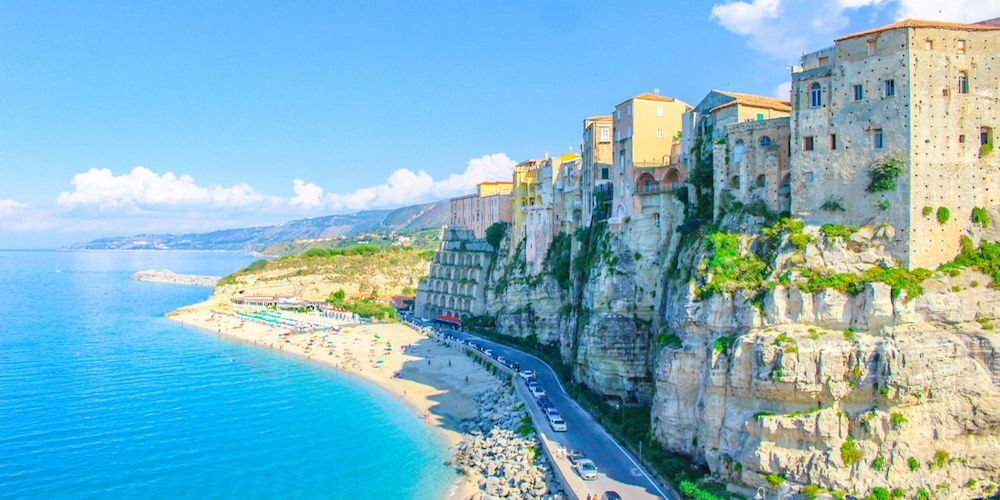
The Spiaggia della Rotonda, with its fine white sand contrasting beautifully with the crystal-clear turquoise waters of the Tyrrhenian Sea, lies at the foot of Tropea’s historic center, framed by the cliffs on which the town sits.
From the center, you can reach the beach by descending a steep and scenic staircase that leads directly to Via Lungomare.
Once you arrive, you can admire the grandeur of Tropea, perched atop the promontory above, and enjoy the breathtaking view of the sea. From here, you can also see the Sanctuary of Santa Maria dell'Isola, which adds a touch of charm to the already stunning landscape.
The waters of the Rotonda are renowned for their exceptional clarity, with shades ranging from turquoise to deep blue, making them irresistible for a swim or some snorkeling.
At the far end of the beach lies the charming Grotta di San Leonardo. Beyond it, you’ll find the Spiaggia del Cannone, another hidden gem of Tropea.
The Spiaggia du Cannuni, as it’s called in the local dialect is more secluded and less crowded than the other beaches, making it ideal for those seeking peace and relaxation away from the hustle and bustle. Surrounded by rocks and accessible via a small path, it offers an intimate and serene environment where you can fully enjoy the sea in complete tranquility.
The red gold of Tropea

The beauty of Tropea comes from its history, its enchanting landscapes, its monuments and museums. But also from its incredible culinary culture, with typical recipes and exceptional products, among which the extraordinary red onion of Tropea must be included.
Cultivated along the Tyrrhenian coast of Calabria, caressed by the sea breeze and nourished by mineral-rich soil, this onion has a flavor like no other. It stands out for its bright red color, elongated shape, and sweet, delicate taste.
It’s not just a simple ingredient, but a true gastronomic icon, loved as much for its aromatic profile as for its ancient history. In fact, the red onion of Tropea has, over the centuries, graced tables across Europe, evolving from a humble vegetable into a symbol of culinary excellence.
And its fame is well-deserved: crunchy and juicy, it can be enjoyed raw, enhancing salads and fresh dishes, thanks to its natural sweetness that eliminates the harshness of common onions.
However, it truly shines when cooked, transforming even the simplest dishes into a unique culinary experience, offering a sensory journey through the flavors and history of Calabria.
How to reach Tropea
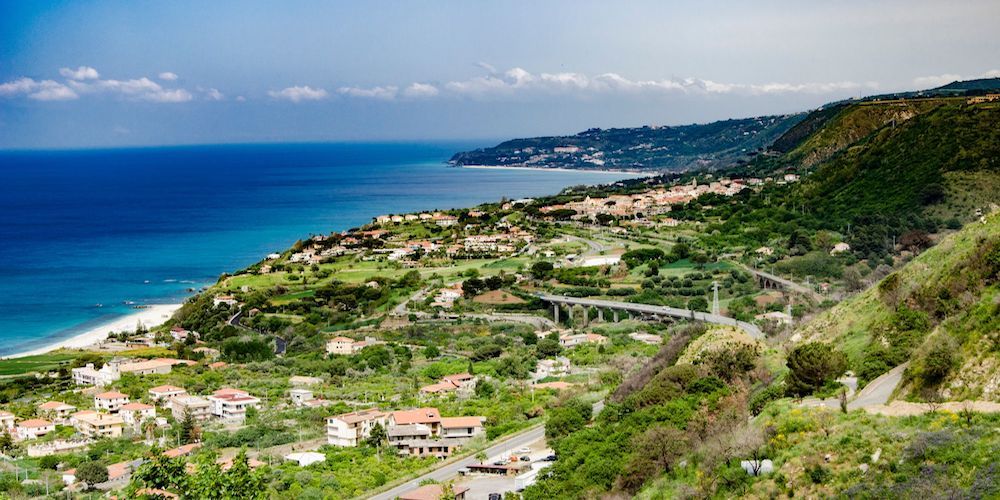
To reach the beautiful town of Tropea, the most convenient airport is Lamezia Terme, located just 60 km away. From there, you can continue by train, with regional connections that will take you directly to your destination. However, since only local trains stop in Tropea, traveling this way may take a bit more time.
If you'd prefer to visit the stunning Coast of the Gods with more freedom, the best option is to rent a car directly at Lamezia airport. This way, you can explore the area by traveling on the road, without time constraints, discovering hidden gems and unspoiled beaches along the coast.
You'll be able to move around in complete autonomy and fully live the magic of the Tyrrhenian Calabria, where every turn reveals breathtaking panoramic views. This way, your experience in Tropea and its surroundings will be even more unforgettable!

